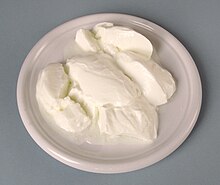
Back Jogurt Afrikaans Meolcbrīw ANG زبادي Arabic Yogur AST Yoğurt Azerbaijani یوقورت AZB Йогурт Bashkir Ёгурт Byelorussian Ёгурт BE-X-OLD Taèru BEW
 A plate of yogurt | |
| Type | Fermented dairy product |
|---|---|
| Place of origin | Probably Mesopotamia, Central Asia ~5,000 BC and independently in different places |
| Serving temperature | Chilled |
| Main ingredients | Milk, bacteria |
Yogurt (UK: /ˈjɒɡət/; US: /ˈjoʊɡərt/,[1] from Ottoman Turkish: یوغورت, romanized: yoğurt;[a] also spelled yoghurt, yogourt or yoghourt) is a food produced by bacterial fermentation of milk.[2] Fermentation of sugars in the milk by these bacteria produces lactic acid, which acts on milk protein to give yogurt its texture and characteristic tart flavor.[2] Cow's milk is most commonly used to make yogurt. Milk from water buffalo, goats, ewes, mares, camels, and yaks is also used to produce yogurt. The milk used may be homogenized or not. It may be pasteurized or raw. Each type of milk produces substantially different results.
Yogurt is produced using a culture of Lactobacillus delbrueckii subsp. bulgaricus and Streptococcus thermophilus bacteria. Other lactobacilli and bifidobacteria are sometimes added during or after culturing yogurt. Some countries require yogurt to contain a specific amount of colony-forming units (CFU) of bacteria; for example, in China the requirement for the number of lactobacillus bacteria is at least 1 million CFU per milliliter.[3]
The bacterial culture is mixed in, and a warm temperature of 30–45 °C (86–113 °F) is maintained for 4 to 12 hours to allow fermentation to occur, with the higher temperatures working faster but risking a lumpy texture or whey separation.[4][5]
- ^ "YOGURT | meaning in the Cambridge English Dictionary". dictionary.cambridge.org. Retrieved 17 February 2020.
- ^ a b "Yogurt: from Part 131 – Milk and Cream. Subpart B – Requirements for Specific Standardized Milk and Cream, Sec. 131.200". Code of Federal Regulations, Title 21, US Food and Drug Administration. 1 April 2016.
- ^ Lee YK, et al. (2012). "Probiotic Regulation in Asian Countries". In Lahtinen S, et al. (eds.). Lactic Acid Bacteria: Microbiological and Functional Aspects (Fourth ed.). Boca Raton: CRC Press. p. 712. ISBN 9780824753320.
- ^ Clark M. "Creamy Homemade Yogurt Recipe". NYT Cooking. Retrieved 19 March 2017.
- ^ "The Science of Great Yogurt". Retrieved 28 September 2021.
Cite error: There are <ref group=lower-alpha> tags or {{efn}} templates on this page, but the references will not show without a {{reflist|group=lower-alpha}} template or {{notelist}} template (see the help page).